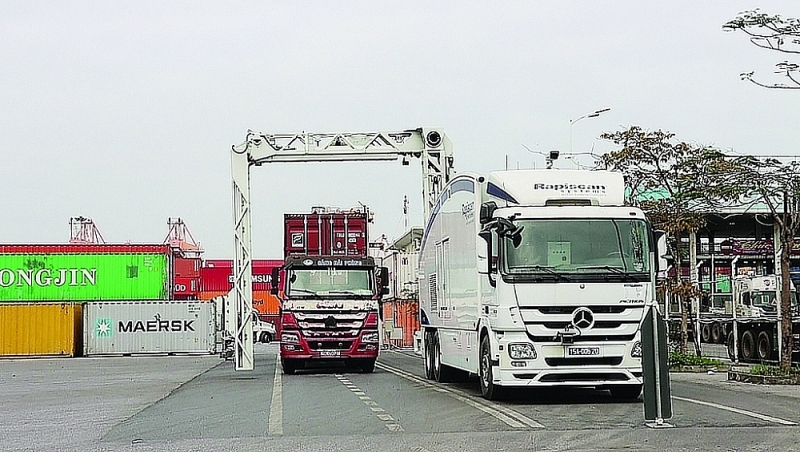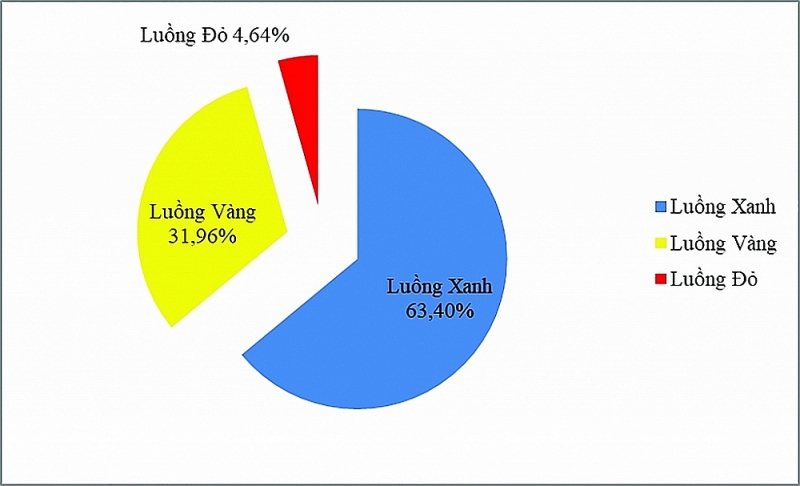 |
| Mobile container scanners perform screening activities at Tan Vu port, Hai Phong. Photo: Thai Binh |
Screening efficiency increased by 68%
In recent years, the application of risk management in customs operations has rapidly developed. Measures to encourage enterprises to comply well with the law, strengthen inspection and control of key subjects and high-risk goods have been applied in harmony with the requirements of facilitating import and export activities and ensuring the requirements of state management of customs, promoting the fast clearance of goods, reducing the costs incurred by the customs authorities and enterprises. Risk management professional techniques and measures are increasingly focused, gradually developed in-depth, and implemented synchronously and uniformly, ensuring the role of 24/7 smooth and fully responsive stream processing, requirements for the automation and electronification of customs procedures.
In the screening of import and export goods, the General Department of Customs directs to monitor the screening situation in the areas closely, actively exchanges and coordinates with the local customs departments that have scanners to guide and handle timely problems related to selection and screening in the area. On the other hand, in coordination with customs branches, Customs Control Teams in localities coordinate screening goods, creating maximum convenience for enterprises to perform scanning through scanners located at seaports or located at the checkpoint outside the border gate, suitable for the transport route and at the request of the enterprise. In addition, the General Department of Customs continues to conduct risk analysis and assessment, identify key areas and industries to warn about risks and propose appropriate risk control measures for consignments showing signs of risk, and signs of violation.
Through screening in October 2022, it shows that scanners ensure the efficiency and effectiveness of screening, with the total number of scanning containers in the sector reaching 11,783 containers (up 68% over the same period last year, 2021), suspect containers reached 769 containers (accounting for 6.53%/total containers, up 1.5 times over the same period), violating containers reached 69 containers (reaching 9%/total suspicious containers, up 19% compared to the same period in 2021), the detection rate of violations reached 0.6%/total container screened. The detected violations were a mainly false declaration of the quantity of transit goods, incorrect declaration of quantity and type, import of undeclared goods, prohibited goods, etc.
 |
| The chart shows the results of selectivity in October 2022. Source: General Department of Customs. |
Applying advanced technology to the work of selectivity
The plan to reform, develop and modernize the Customs sector by 2025 has set out groups of solutions such as institutions, customs procedures, customs supervision and inspection, risk management, post-clearance inspection, etc.
In particular, for risk management, it is necessary to continue to implement synchronously and fully the application of risk management in customs professional activities, on the basis of promoting digital transformation of risk management activities in customs digital transformation, implementing digital customs, towards smart customs, applying science and technology of the industrial revolution 4.0 (integration of big data, AI, intelligent analysis) to improve risk management in the fields of application used in the screening decision for import and export goods; channeling inspection during customs procedures; applied in deciding methods of supervision and inspection during the customs supervision of goods; support risk warning in management for types of processing, export production, export processing; applied in the management of enterprises dealing in tax-free goods; applied in the management of imported goods with high risks of causing environmental pollution and climate change towards Green Customs.
At the same time, improving the effectiveness of compliance assessment and risk classification for customs declarants, warehouses, yards and port businesses; applied in management for other professional activities (classification of tax refund dossiers, applied in post-clearance inspection, sampling for analysis, classification and inspection).
The General Department of Customs has assigned the Department of Risk Management to assume the prime responsibility for coordinating with units in the sector to deploy solutions on advanced scientific applications of the 4.0 industrial revolution, big data integration, and intelligent analysis to improve the professional application of risk management in screening decisions for import and export goods. Accordingly, in 2022 and 2023, keep on coordinating to build automatic IT solutions to support risk analysis and assessment, and identify key points to decide on screening goods to meet digital customs. At the same time, from 2022 to 2025, coordinating to build the functions of the IT system to meet the digitization of information, connecting information and data, automatically supporting analysis to identify key points, and selecting screening.
In addition, the application of advanced science and technology of the industrial revolution 4.0 improves the quality and efficiency of the selectivity. Therefore, the General Department of Customs requested the Department of Risk Management to coordinate in implementing solutions to reduce the rate of inspection threading each year. At the same time, reviewing and evaluating the actual situation of applying risk management to perfect the risk assessment technique, applying criteria in the direction of focusing on controlling high risks in the field of customs operations.
 | The importance of building a centralized interdisciplinary risk management center |
| Statistics from the General Department of Customs show that the percentage of shipments subject to physical inspection of goods in customs procedures has decreased significantly over the years. For example, if in 2011, the actual inspection rate was 12.62%, by 2020, this rate will decrease to 5.17%, then by October 2022, this rate will continue to decrease to 4.64%. |
